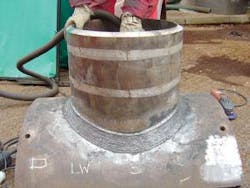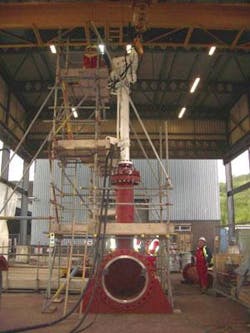Welding preparations pay off for Forties pipeline hot tap
Joe McCann and Matthew Kirk; Stolt Offshore
Last August, Stolt Offshore completed the largest subsea welded hot tap to date in the UK sector of the North Sea, following a carefully planned series of operational trials. Stolt designed the 18-in. hot tap to facilitate oil export from the Nexen-operated Buzzard field, currently under development, into the 36-in. BP owned and operated Forties Pipeline System (FPS). The latter is a major energy artery transporting 600,000 b/d, equating to output from over 30 fields in the central North Sea.
From the outset of the project, BP insisted there was to be an extensive assurance process for each stage of the project, and there could be no interruption to existing FPS activities during the tie-in operation.
Stolt used its experience from four previous welded subsea hot taps in the North Sea and proposed a series of trials and practice runs to demonstrate to all stake holders that the offshore operations would run according to plan.
There were some challenges specific to this project. First, all the previous hot tap assignments had applied to gas export facilities - Buzzard’s would be the first oil export hot tap. Second, due to the requirement for pigging, Stolt would have to take care in obtaining the tight tolerances needed to minimize the lip between the cut hole in the parent pipe and the inside of the branch nipple.
In preparation, Stolt implemented a meticulously planned program of familiarization and training for personnel connected with the two key stages of the project, i.e., the hyperbaric welding phase and the hot tap phase.
Hyperbaric welding
To meet its commitment concerning non-interruption of FPS flow during hot tap construction, Stolt applied its patented induction heating system in two of the four welds, namely the buttering layer onto the FPS and the branch nipple to FPS butt weld.
Another prime objective was for Stolt to achieve good hyperbaric welds in a safe manner and in an optimum time-frame. Key to achieving this goal was the selection of a competent and experienced welding dive team that would work effectively and coherently as a team, who were fully acquainted with all the equipment and processes, and who would participate in appropriate ‘dry runs’ or trials to achieve the sought-after state of readiness.
Stolt assembled the welding dive team at the National Hyperbaric Centre (NHC) in Aberdeen 14 weeks prior to mobilization to run through the stages of preparation.
In the latter stages, additional non-destructive testing (NDT) divers were brought in, ensuring that the offshore dive team had full understanding of all the tasks to be performed offshore.
The welding team produced special weld simulators to represent the full flow conditions of oil through the FPS. The team employed these during the welding qualifications and the full-scale onshore welding trials. It then added cooling elements internally, fabricated from spare joints of the FPS, to recreate the heat dissipation effect of the oil flowing through the FPS.
The culmination of the familiarization and qualification program was a full-scale onshore welding trial performed within the welding habitat, using a weld simulator and the induction heating system. The weld simulator represented the FPS and the associated cooling effect of hydrocarbon flow within the pipeline. The welding team employed the induction heating system for the buttering and branch to main pipeline weld. The team performed all four welds and subjected them to full NDT examination, then installed and fully fitted the reinforcement sleeve.
All operations conducted within the rigged-up habitat mimicked exactly the intended offshore operations. This included communications with the welder divers and equipment storage and deployment within the habitat. The operation took 24 hours, with standard diver rotations.
In a hyperbarically welded hot tap operation, all preparatory activities, such as welding, should not impact the integrity of the parent pipeline. The specific aim of the hot tap is to break this integrity in a meticulously engineered and controlled manner.
Early in the project, Stolt awarded T.D. Williamson the contract to supply the hot tap equipment. Two complete systems were required to ensure 100% redundancy on all items. A subsea hydraulic power unit, controlled via an electrical umbilical and a topside electrical control cabinet on surface, powered the tapping machine, which was itself pressure balanced. This allowed the tapping machine body pressure to equalize with the pipeline pressure when containment was broken. This facility ensured that the components within the tapping machine were only exposed to cutting loads with no additional pressure loading generated by the pipeline pressure.
As part of the assurance process, both tapping machines were subjected to a 24-hour strength test. Analysis of the main components and seals materials confirmed that the tapping machine could remain attached to the pipeline while exposed internally to hydrocarbon for up to six months without any possible loss of containment.
Three separate cutting trials were staged to:
- Examine the operability of the tapping equipment
- Determine the optimum machine settings for cutting into Forties pipeline material
- Examine the durability of the pilot drill and cutter assemblies
- Investigate the swarf size and location of swarf deposits during the tapping process.
In parallel, divers and dive supervisors who would be operating the hot tap machine offshore completed a comprehensive diver training program. This allowed the dive teams to familiarize themselves with the equipment that would be used subsea and to operate it in advance of the actual operation.
Diver training focused on:
- Set-up of the tapping machine and connecting the hydraulic control system
- Operation of the tapping machine and familiarization with the devices used for monitoring the progress of the tap
- Performance of contingency procedures to address plausible events that could occur during the tapping process, such as difficulty in removing the hot tap machine from the branch assembly.
The team made 20 cuts through 30-mm-thick X65 grade flat plate steel. Flat plate would provide the most onerous cutting environment for the tapping machine, as all the cutter teeth would be engaged on the cutting surface simultaneously. This trial run demonstrated the tapping machine’s durability. It also allowed the team to examine the effectiveness of the integrated pipe coupon retention system.
A jig simulated the distance the cutter would travel when moving from its storage position to engagement on the crown of the pipeline. Where relevant, the geometry of the jig was an exact duplication of the complete welded branch assembly. During each tap, the process was monitored for stalling of the tapping machine, bluing of the steel swarf, and unexpected hydraulic pressure increases within the drive unit. This program allowed the team to establish the optimum settings for the hot tap machine.
Cutting trials on spare pipeline sections
The main aims of the second set of trials were to facilitate practice, to demonstrate the effectiveness of the cutter centralizing mechanism, and to prove that the selected cutter would cut through actual sections of the FPS 36-in. pipeline.
On completion of previous hot taps, the residual internal lip left within the branch nipples had been about 20 mm (on radius), because there was no requirement to pig the hot tap assemblies. As the branch line from Buzzard will export oil into the FPS, however, this particular hot tap had to be piggable, necessitating reduction of the internal lip size to 6 mm (on radius). To this end, the team employed a 410-mm cutter inside the 422-mm ID branch nipple. Due to the tight tolerances, the team fitted a centralizing device to the back of the cutter to ensure that the removed coupon was concentric with the internal diameter of the branch nipple.
It constructed a second jig for these trials to accommodate the spare sections of Forties pipe. As previously, the dimensions of the set-up replicated that of the subsea hot tap arrangement.
A comprehensive series of cuts demonstrated the durability of the hot tap machine, the successful removal and retention of each trial cut coupon, and the functionality of the centralization mechanism. Following closer examination of the internal lip profile, the centralizing mechanism functioned as expected. The produced lip was of the required size and was concentric to the inner diameter of the branch nipple.
To ensure diver safety and to minimize potential contamination of the marine environment, the team purged the void between the hot tap machine and upper gate valve seal of hydrocarbon before disconnecting the hot tap machine from the gate valve. Purging trials then examined the effectiveness of the proposed cleansing agents and also determined the flushing volumes needed to achieve an acceptable level of hydrocarbon content within the void space.
The team performed a final dry run trial prior to mobilization of the offshore operations. The objectives were to facilitate a final practice on the hot tap, rehearse construction activities, and demonstrate preparedness. This trial consisted of a complete dry run of all the construction activities that were to be performed in the forthcoming offshore phases of work - with the exception of the hyperbaric welding operations that had previously been subjected to a separate dry run rehearsal.
The team deployed a previously prepared welded hot tap assembly, replicating the expected configuration of the hot tap branch nipple and reinforcement sleeve arrangement, welded onto a spare section of Forties pipeline. The team fitted the line pipe section with flanges at either end to allow the pipe section to be pressurized to the line pressure anticipated at the offshore worksite, using diesel as the pressurization medium.
It positioned the simulated assembly within the confines of the hot tap protection structure with the hot tap branch nipple positioned relative to the protection structure as expected offshore.
Once the team established this arrangement, it performed a further series of trials:
- The upper structure mated with the lower structure to ensure they could mate correctly
- The pile locking mechanism was tested using test sections of the fabricated piles
- The hot tap pipe work support clamps were installed onto a test section of 36-in. pipe and secured
- All temporary works items which interfaced with the main structure, were test fitted to verify correct fitting and operation.
Finally, the team performed a full hot tap in the pressurized simulator. It set the tapping machine operational parameters in accordance with the criteria established in the hot tap trial program. To simulate the communication lines offshore, trained divers operated the hot tap machine under direct instruction from the dive supervisor via a UHF radio link.
Last July and August, Stolt performed the offshore construction activities from theSeaway Eagle and Seaway Osprey DSVs. The program proved to be 100% successful, with a smooth execution of the cutting operation resulting in the removal and recovery of the pipe coupon.



